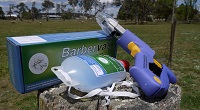Zolvix resistance in Queensland
 Zolvix (Active ingredient: monepantel) resistance in Barbers Pole was first reported a few months ago in a goat herd in New South Wales. Now monepantal resistance has been confirmed from a Haemonchus contortus strain (Barbers Pole) isolated from sheep on a property in south western Queensland and a Trichostrongylus colubriformis (Scour worm) strain isolated from northern NSW. The work was done by Veterinary Health Research Pty. Ltd. from Armidale and involved artificial infection, sacrifice and total worm count efficacy studies. Further details will be available, from Veterinary Health Research, over the coming few weeks as to the how, why and when. Leading Sheep will keep you informed. In the meantime what can you do to make your worm control better and keep the drenches you have currently working available, for you, for longer.
Zolvix (Active ingredient: monepantel) resistance in Barbers Pole was first reported a few months ago in a goat herd in New South Wales. Now monepantal resistance has been confirmed from a Haemonchus contortus strain (Barbers Pole) isolated from sheep on a property in south western Queensland and a Trichostrongylus colubriformis (Scour worm) strain isolated from northern NSW. The work was done by Veterinary Health Research Pty. Ltd. from Armidale and involved artificial infection, sacrifice and total worm count efficacy studies. Further details will be available, from Veterinary Health Research, over the coming few weeks as to the how, why and when. Leading Sheep will keep you informed. In the meantime what can you do to make your worm control better and keep the drenches you have currently working available, for you, for longer.
- This result highlights the importance of good quarantine drenching so that you do not buy someone else’s problem with purchased sheep, lambs or rams. Who would have suspected the first report of monepantel resistance in sheep would have come from south west Queensland? Even a few stragglers that get over to the neighbours may bring back more than you bargained for.
- You cannot assume even newer drenches are working 100%. As part of good worm management you should periodically follow up all drenches with a worm egg count 10 to 14 days later (DrenchCheck Day10) to make sure the drench has worked.
- Visit WormBoss (www.wormboss.com.au) and look for the ‘Your Program’ heading then click on the region that is applicable to your property. This is good information that is very practical, easily understood and applied. The Drench Decision Guide (under the ‘Tests and Tools’ heading) for your region is also a valuable resource.
That was the bad news now for the good.
Barbervax: Vaccinating against Barbers Pole
 The release of the new Barbervax vaccine is great news. Barbervax is now registered for use in lambs. A series of five subcutaneous injections of 1ml is required at approximately six week intervals to cover the Barbers Pole worm-risk season. In most cases the first vaccination will be given at lamb marking, a second 3 to 5 weeks later followed by at weaning and so on. The weaning vaccination is accompanied by a drench to remove existing Barbers Pole burdens and to control other worm species. In trials in New South Wales the vaccine has worked well against Barbers Pole. Registration is being sought for use in yearling and adult sheep and trials are proceeding in goats.
The release of the new Barbervax vaccine is great news. Barbervax is now registered for use in lambs. A series of five subcutaneous injections of 1ml is required at approximately six week intervals to cover the Barbers Pole worm-risk season. In most cases the first vaccination will be given at lamb marking, a second 3 to 5 weeks later followed by at weaning and so on. The weaning vaccination is accompanied by a drench to remove existing Barbers Pole burdens and to control other worm species. In trials in New South Wales the vaccine has worked well against Barbers Pole. Registration is being sought for use in yearling and adult sheep and trials are proceeding in goats.
It is important to know that the first two vaccinations are not able to provide protection but they prime the lamb’s immune system so that protection occurs following the third vaccination and lasts for at least 6 weeks. Further vaccinations need to be given every six weeks whilst there is a Barbers Pole risk. Because the number of Barbers Pole larvae on pasture remains low even the small percentage of lambs that do not respond to vaccination are not faced with a significant larval intake. Trial work suggests that in the second year the first injection restores the immunity, with six weekly boosters needed thereafter.
Whilst not for everyone, Barbervax is a valuable new tool. Barbervax production will be increased in coming years from the first 300,000 doses (sufficient for 60,000 lambs). All of these doses have been already sold. For further information about Barbervax click here.
Noel O’ Dempsey
Leading Sheep South Region Coordinator
(07) 4653 1441
odempsn@harboursat.com.au
